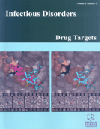-
oa Strategic Paradigm Shifts in the Antimicrobial Drug Discovery Process of the 21st Century
- Source: Infectious Disorders - Drug Targets (Formerly Current Drug Targets - Infectious Disorders), Volume 7, Issue 3, Sep 2007, p. 230 - 237
-
- 01 Sep 2007
Abstract
The numbers of global infections produced by bacterial strains that are resistant to single and multiple antimicrobial drugs are on the rise. Concomitant with this alarming upward trend, there is a clear downward trend in the intent and determination of pharmaceutical companies to develop novel antimicrobials. One of the pressing goals to confront the twenty first century's public health challenges brought about by the escalating antibacterial drug resistance problem is the development of an armamentarium of new chemotherapeutic agents. Two interconnected strategic paradigm shifts in the drug discovery process that are anticipated to facilitate the achievement of this goal are discussed herein. One is an antimicrobial to anti-infective (ATA) paradigm shift. The other is a shift from a target candidate prioritization (TCP) paradigm that is dominated by an essential target preference criterion to an alternative paradigm that relies on a less restrictive criterion, one that does not exclude conditionally essential targets. Examples of conditionally essential targets for the development of anti-infectives include the enzymes involved in the biosynthesis of small-molecule virulence effectors such as non-ribosomal peptide-polyketide-derived iron-scavenging siderophores. Siderophores are utilized for iron uptake by many pathogenic bacteria, including Mycobacterium and Yersinia species. The recent progress towards developing inhibitors of siderophore biosynthesis is discussed herein.


